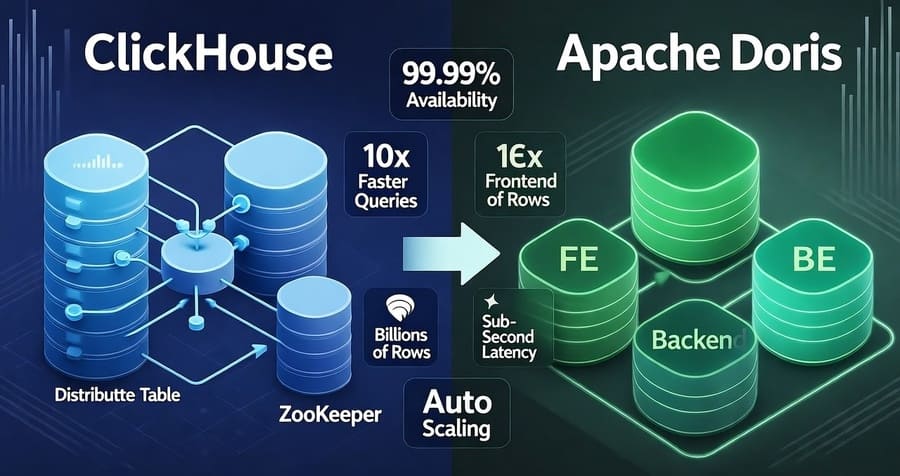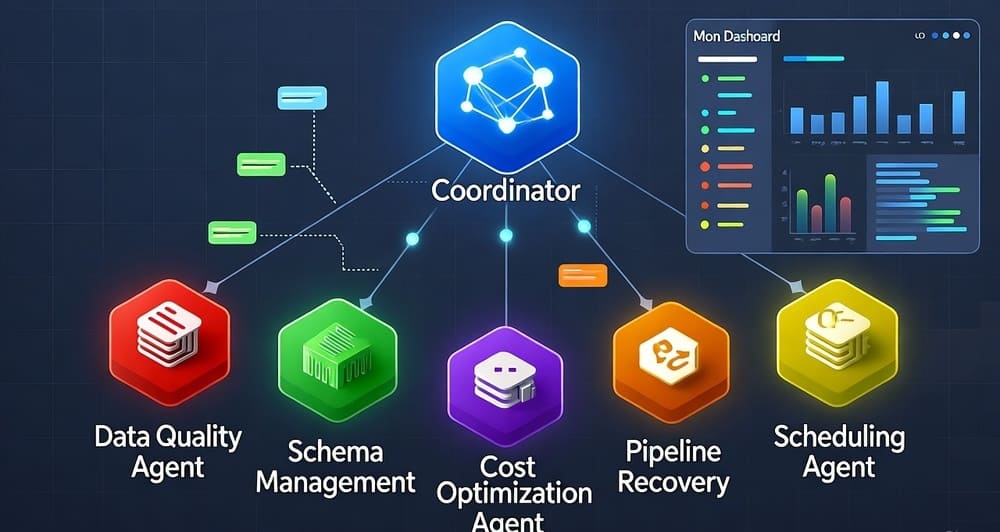Apache Iceberg: High-Performance Format for Huge Analytic Datasets
In the world of big data, performance isn’t just a luxury—it’s a necessity. As organizations amass petabytes of information, traditional data storage approaches buckle under pressure, leading to slow queries, unreliable results, and frustrated data teams. Apache Iceberg emerged as a response to these challenges, offering a revolutionary table format designed specifically for massive analytical workloads.
Beyond Traditional Data Formats
Before diving into Iceberg’s capabilities, it’s important to understand why conventional approaches fall short. Traditional data lake storage typically relies on simple directory structures with files organized by partition. This seemingly straightforward approach brings several critical limitations:
- Schema Evolution Challenges: Adding or modifying columns often requires rewriting entire datasets
- Partition Evolution Problems: Changing partition schemes means migrating all your data
- Performance Bottlenecks: Directory listings become expensive at scale
- Limited Consistency Guarantees: No atomic operations across multiple files
- Poor Handling of Small Files: Performance degrades with many small files
Apache Iceberg addresses these limitations through its innovative table format design, providing capabilities previously available only in sophisticated data warehouses, but with the openness and flexibility of data lake architectures.
What Makes Apache Iceberg Different
At its core, Iceberg is an open table format that maintains a central metadata repository tracking all files belonging to a table. This seemingly simple architectural choice enables powerful capabilities:
1. Schema Evolution Without Rewrites
Iceberg tracks schema versions independently from data files, allowing columns to be added, renamed, reordered, or even have their types changed without expensive data migrations:
java// Adding a new column is a simple metadata operation
Table table = ...
table.updateSchema()
.addColumn("user_interest", Types.StringType.get())
.commit();
2. Partition Evolution
Unlike traditional Hive-style partitioning, Iceberg separates the physical data organization from the logical partition scheme, enabling partition evolution without data movement:
java// Change partitioning without moving data
table.updateSpec()
.addField(Expressions.month("event_time"))
.removeField("user_region")
.commit();
This hidden gem alone can save organizations from painful and risky data migrations.
3. Hidden Partitioning with Partition Transforms
Rather than exposing raw partition values in paths, Iceberg uses partition transforms that map data values to partitions:
- Identity: Use the value directly
- Bucket: Hash the value into a fixed number of buckets
- Truncate: Remove precision from decimal values
- Year/Month/Day/Hour: Extract date parts from timestamps
java// Creating a table with sophisticated partitioning
Table table = catalog.createTable(tableId, schema,
PartitionSpec.builderFor(schema)
.year("event_time") // Extract year from timestamp
.bucket("user_id", 8) // Hash into 8 buckets
.build());
This approach provides efficient filtering without exposing implementation details.
4. ACID Transactions
Iceberg provides ACID guarantees through snapshot isolation:
- Atomicity: All changes in a transaction are visible together
- Consistency: Readers always see a consistent view
- Isolation: Concurrent reads and writes won’t conflict
- Durability: Once committed, data is never lost
java// Atomic operations
Transaction txn = table.newTransaction();
txn.updateProperties()
.set("commit-user", "data-engineer")
.commit();
txn.updateSchema()
.addColumn("tags", Types.ListType.ofRequired(Types.StringType.get()))
.commit();
// Both operations commit together
txn.commitTransaction();
5. Time Travel and Rollback
Iceberg maintains a history of table states, enabling:
java// Query a table at a specific point in time
Table table = ...
table.history().forEach(System.out::println);
// Read table as of a specific snapshot ID
Dataset<Row> df = spark.read()
.option("snapshot-id", 10963874102873L)
.format("iceberg")
.load("db.table");
// Or as of a timestamp
Dataset<Row> df = spark.read()
.option("as-of-timestamp", System.currentTimeMillis() - 86400000) // 1 day ago
.format("iceberg")
.load("db.table");
6. Optimized Performance
Iceberg incorporates multiple performance optimizations:
- Statistics and Metadata Filtering: Skip files that can’t contain matching records
- Hidden Partitioning: Filter data without knowing implementation details
- Z-Order Clustering: Multi-dimensional clustering for correlated filters
- Vector Indexing: Efficient skipping of file sections
- Metadata Indexing: Fast lookup for relevant data files
Technical Implementation
Iceberg’s architecture consists of several key components:
Table Metadata and Snapshots
The heart of Iceberg is its metadata layer, which tracks:
- Table schemas (past and present)
- Partition specs (past and present)
- Snapshots (points in time)
- Manifest files (lists of data files)
- Data files (the actual data)
This metadata tree allows Iceberg to perform sophisticated operations without scanning all data.
File Format Support
Iceberg works with multiple file formats:
- Apache Parquet (recommended for most use cases)
- Apache ORC
- Apache Avro
Engine Compatibility
One of Iceberg’s strengths is its compatibility with various processing engines:
- Apache Spark
- Apache Flink
- Presto/Trino
- Dremio
- AWS Athena
- Snowflake
- Google BigQuery
Practical Use Cases
Data Governance and Compliance
Iceberg’s time travel capabilities make it ideal for compliance scenarios:
java// Find when a table was changed and by whom
table.history().forEach(snapshot -> {
System.out.printf("Snapshot %s was created at %s by %s\n",
snapshot.snapshotId(),
new Date(snapshot.timestampMillis()),
snapshot.summary().getOrDefault("user", "unknown"));
});
Optimized Data Lake Architecture
Iceberg enables data lakehouse architectures with warehouse-like performance:
java// Optimize a table for better read performance
spark.sql("CALL catalog.system.rewrite_data_files(" +
"table => 'db.sample', " +
"strategy => 'bin-pack', " +
"options => map('target-file-size-bytes', '536870912')" +
")");
Multi-Engine Workloads
Organizations can use different engines for different tasks on the same data:
- Spark for batch processing
- Flink for streaming
- Presto/Trino for interactive queries
Performance Benchmarks
In real-world scenarios, Iceberg demonstrates significant advantages:
- Query Performance: 2-5x faster queries due to metadata filtering
- Schema Evolution: Instant schema changes vs. hours or days for rewrites
- Partition Evolution: Zero-copy repartitioning vs. full data migration
- Compaction Operations: Background optimization without blocking readers
Implementing Apache Iceberg
Getting Started
Setting up Iceberg with Spark is straightforward:
java// Create a catalog
spark.sql("CREATE NAMESPACE IF NOT EXISTS analytics");
// Create a table
spark.sql("CREATE TABLE analytics.events (" +
" user_id bigint," +
" event_time timestamp," +
" event_type string," +
" page_url string," +
" country string)" +
"USING iceberg " +
"PARTITIONED BY (days(event_time), bucket(16, user_id))");
// Write data
spark.sql("INSERT INTO analytics.events VALUES " +
"(1, timestamp '2022-01-01 10:00:00', 'pageview', '/home', 'US')");
// Read data
spark.sql("SELECT * FROM analytics.events").show();
Catalog Options
Iceberg supports multiple catalog implementations:
- Hive Metastore
- AWS Glue
- JDBC
- REST Catalog (for cloud-native architectures)
- Custom catalogs
Maintenance and Optimization
To maintain optimal performance:
java// Expire old snapshots
spark.sql("CALL catalog.system.expire_snapshots(" +
"table => 'db.sample', " +
"older_than => TIMESTAMP '2023-01-01 00:00:00', " +
"retain_last => 5)");
// Compact small files
spark.sql("CALL catalog.system.rewrite_data_files(" +
"table => 'db.sample')");
Apache Iceberg vs. Alternatives
When comparing to other formats:
Apache Hudi:
- Both provide ACID guarantees
- Hudi excels at record-level updates and deletes
- Iceberg focuses on schema and partition evolution
Delta Lake:
- Both offer similar core functionality
- Delta Lake has tighter Databricks integration
- Iceberg has broader community adoption and multi-engine support
Real-World Success Stories
While specific company names are omitted, the pattern of benefits is clear:
- Large Tech Companies: Reduced query times from hours to minutes
- Financial Institutions: Achieved compliance with time travel capabilities
- E-commerce Platforms: Enabled real-time analytics on petabyte-scale data
- Media Companies: Simplified multi-engine workflows across teams
Future Directions
The Iceberg community continues to innovate with features like:
- Enhanced vector indexing for even faster queries
- Extended REST catalog capabilities
- Improved integration with stream processing
- Standardized table formats through the Table Format initiative
Conclusion
Apache Iceberg represents a significant leap forward in data lake technology, bringing together the best features of traditional data warehouses with the flexibility and openness of data lakes. By addressing fundamental limitations of older approaches, Iceberg enables organizations to build data architectures that are not just larger but dramatically more efficient, reliable, and maintainable.
Whether you’re dealing with petabyte-scale analytics, complex compliance requirements, or multi-engine data workflows, Apache Iceberg provides a solid foundation for your modern data stack. As data continues to grow in volume and importance, technologies like Iceberg will be essential for organizations seeking to extract maximum value from their information assets.
Hashtags: #ApacheIceberg #DataLakehouse #BigData #DataEngineering #AnalyticDatasets #OpenSource #SchemaEvolution #ACID #DataArchitecture #PerformanceOptimization





